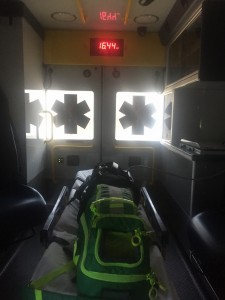This week I had an opportunity to do a ride-along with Person County EMS. I also had the opportunity to experience my first budget work session.
Some quick facts about Person County EMS:
- There are four trucks and the crew does 24-hour shifts.
- Three of the trucks are full time and the fourth is staffed during peak hours (8am-7pm).
- The Person County EMS building is a fallout shelter which explains the many short hallways
I was told the crew had a rough previous day. That day started with a pretty severe car accident and a workplace accident involving a man falling off a roof and being impaled by factory equipment. During my ride-along we had two calls and assisted with the transfer of the body from the workplace accident from the hospital to the medical examiner.
Given how stressful the previous day was, the crew was hoping for a slower day. The day was certainly slower (at least for my short visit). Our two calls involved assisting elderly women with various medical concerns needing hospital transport. I really got to see some of the challenges in dealing with patients during our second call. This call involved responding to a spunky elderly woman who was experiencing chest pains. After some difficulty locating the woman’s veins, Sally, one of the EMS drivers was able to set up an IV drip and hook the woman up to a machine to monitor her vitals.
Despite being given medication for her pain and vitals that were not unusual, the woman kept asking “Am I dying?” Sally kept reassuring the woman that she wasn’t dying, but the woman was likely scared and couldn’t see past the pain she was experiencing (The woman also questioned Sally’s credentials). Sally did a great job of trying to keep the woman calm, responding to questions in a firm but respectful manner, and distracting the woman from thinking the worst was happening. This call took us further away than I was anticipating and I didn’t realize that we left NC until I saw the “Welcome to Virginia” sign as we were driving back into NC (I was sitting in the back of the truck).
The budget work session was a mostly tame affair–except for an odd chicken and egg exchange between the superintendent and one of the county commissioners. I was tasked with being an extra set of ears to record requests from the County Commissioners and to manage the budget change calculator. The budget change calculator is a simple excel spreadsheet that shows the impact on the overall budget if a revenue or expenditure is added or eliminated. I was a little disappointed that I didn’t get to use it in this session since a lot of changes were tabled for the second work session.
During this session, one of the County Commissioners, Tracy Kendrick, reiterated a point made by Duke Energy CEO Lynn Good that all coal-fired stations in NC would be shut down by 2030–14 years from now. He shared his belief that the two Duke facilities in Person County would be closed within 10 years. Both facilities represent a huge employer in the community and a significant contributor to the tax base. Commissioner Kendrick expressed his desire to make the hard choices today to be proactive rather than reactive to changing conditions. This conversation is not unique to North Carolina as the decline of the coal industry (and the environmental impacts) has received increased attention in recent years (See: The death of US coal and Here’s why Central Appalachia’s coal industry is dying).
This moment, combined with conversations I have been involved with since starting, highlighted for me the challenges of economic development. When I think back to my home state of Michigan, I always questioned why those in government didn’t plan better for what now looks like the obvious decline of the auto industry. Given what I know now, I understand that making the necessary changes and adjustments is much harder than just realizing that there is a problem on the horizon.
Planning for massive shifts in your economy and filling in the gaps or diversifying to minimize the risk that any one industry or company can present is not as simple as saying “we need this company or this sector,” and poof they start building a factory.
The big questions–What services should we be providing? What assets do we have to encourage and support growth? Who should we recruit to provide good paying jobs that will hopefully make additional investments in the community?– are not easily settled in one or two meetings. Over the next few months, I will have the opportunity to further explore these questions and see how Person County is responding to these challenges, while also taking advantage of opportunities to build a better future for the county. I hope this will give me a better perspective and knowledge base as a future public administrator.


